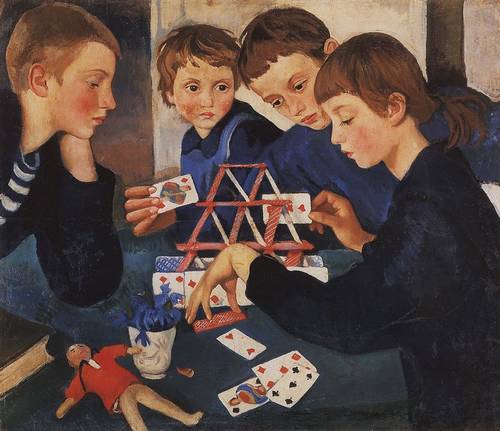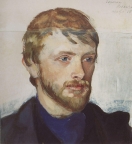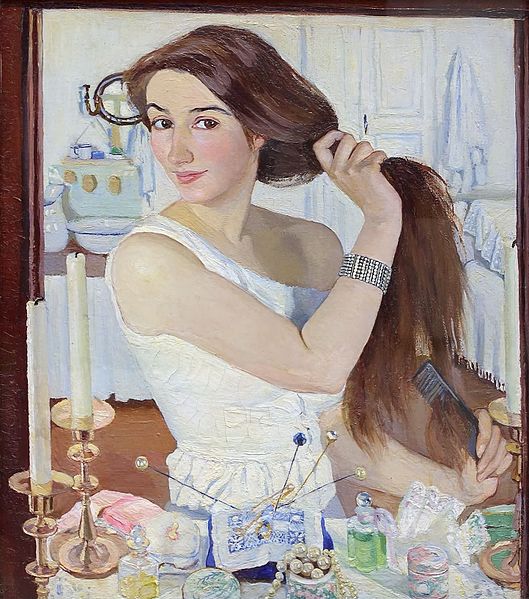
by Zinaida Seberiakova
One of the most pleasing aspects of this blog for me is discovering artists I had never heard of before. It is an even greater pleasure when the “new-to-me” artist is a female for I am often made aware in my look at the lives of painters, the difficulty it has been for a female artist to attain credit for her ability. In the past I have looked at works by Artemisia Gentileschi, Frida Kahlo, Gabriele Münter and Vigée Le Brun, to mention just a few, and I have been mesmerised by their works and the passion that went into them. In my next couple of blogs, I want to introduce you to Zinaida Serebriakova, one of the greatest Russian female artists, whose life story is enthralling and whose works are entrancing.
Zinaida Serebriakova, née Lanceray, was born in 1884, on the family estate of Neskuchnoye, near Kharkov, which now lies in Ukraine. She is descended from two great wealthy and powerful Russian dynasties. On her father’s side there was the Russian Lanceray dynasty and on her mother’s side was the great Franco-Russian Benois family dynasty. Zinaida’s father was the sculptor, graphic artist, and painter, Yevgeny Lanceray, who died when she was just two years of age and her mother was Ekaterina Benois. Zinaida had two brothers, Nikolai and Yevgeny who also excelled artistically and many of her ancestors excelled artistically so it comes as no surprise when she showed both and interest and talent for drawing and painting.

Zinaida spent her childhood and youth split between living in St. Petersburg, where her grandfather the architect Nicholas Benois lived, and at the family estate of Neskuchnoye. Her initial artistic tuition came in 1901 after she had completed her grammar school education the previous year, when at the age of seventeen, she enrolled at the Princess Tenisheva Art School in St Petersburg, where the lead tutor was the distinguished Russian painter and sculptor, Ilya Repin. The following year she travelled to Italy and in 1903 she began a two year apprenticeship at the St Petersburg studio of the Russian portraitist Osip Braz. Living in St. Petersburg she was able to visit the Hermitage Museum and gaze in wonderment at the classical paintings of the Masters. Of all those artists which she admired, the one who stood out the most for her and was to influence her future work was her countryman, Alexey Gavrilovich Venetsianov. He was famous for his paintings which focused on the simple life of ordinary people and the struggle for survival of the peasant classes. He often painted portraits of the peasants and Zinaida was captivated by the innocence and virtuousness of his imagery and many of her future works would incorporate scenes from peasant life. An example of this is the early work which she completed in 1906 entitled Country Girl.

Apart from seeing these works by Venetsianov, she was fortunate to live at Neskuchnoye and savour the beauty of the surrounding countryside and the tranquillity of country life. She also spent much of her time completing portraits of her family members. In 1905, Zinaida Lanceray married Boris Serebriakov, who was her first cousin. They had met at Neskuchnoe whilst he was studying engineering and he would later become a railroad engineer. Zanaida and her husband went off to Paris where she continued her art studies at the Académie de la Grande Chaumière in Paris. This art establishment which was founded three years earlier by the Swiss painter Martha Stettler operated as a ‘free’ academy, where art students, both professional and amateur alike could enter to draw and paint at will.

Her popularity as an artist took off shortly after she exhibited her Self Portrait at the exhibition held by the Union of Russian Artists in 1910. It was a work she had completed the previous year and showed her image, as seen in a mirror, seated at her dressing table, combing her hair. The painting can be seen at the Tretyakov Gallery in Moscow. Her uncle Alexander Benois wrote about this work:
“…A young woman lives in a remote country area … and has no other pleasure, no other aesthetic enjoyment on winter days that seclude her from the whole world, than to see her gay young face in the mirror and to watch the play of her bare arms and hands with a comb … Her face and everything else in the picture is young and fresh. There is not a trace of modernistic refinement. But the simple, real-life atmosphere, illuminated by youth, is joyous and lovely…”
In 1916 Zinaida’s uncle, Alexander Benois was commissioned to decorate the Kazan Railway Station in Moscow and he invited her to help him by becoming part of his team. Serebriakova took on the theme of the Orient: India, Japan, Turkey, and Siam were represented allegorically in the form of beautiful women. It is recognised that the work she produced between 1914 and 1917 were some of her best.

She created a series of works, the theme of which was the rural life she witnessed all around her. In 1917 she completed one such painting entitled Bleaching Cloth which in some way is her homage to the female peasant workers. Against a background formed by a blue sky and partly veiled by light greyish white clouds, we see the women hard at work in the fields with their bales of cloth. The red, green and brown colour of the peasants’ clothes gives the painting a beautiful vibrancy and the figures seen against a very low horizon gives the depicted peasants a commanding and grandiose quality. The work, measuring 142cms x 174cms, was a testament to Zinaida’s talent as a monumental artist. The painting is now held at the Tretyakov Gallery in Moscow.
The year 1917 proved to be her annus horriblis and changed her life and that of her family forever. The Russian Revolution led by the Bolsheviks under the leadership of Lenin started in October of that year and soon spread throughout the country. The Bolsheviks believed that the working classes would, at some point, liberate themselves from the economic and political control of the ruling classes. It was an uprising by the “have-nots against those who had” and as such the family estate owned by Zinaida’s family, where she was living was a target. Much of the estate was taken over or destroyed. All the reserves of Neskuchnoye had been plundered which resulted in the family suffering from hunger. Her husband had been taken away by the Bolsheviks and was incarcerated in jail where he died of typhus in 1919. Zinaida was left without any money and yet was responsible for her four children and her sick widowed mother.
This was a traumatic time in Zinaida’s life and it was in that very year that her husband died that she completed one of her most famous works and which is my featured painting of the day, entitled House of Cards which depicts her four orphaned children, Alexandre, Ekaterina, Eugene and Tatyana playing cards. It is a tragic painting featuring her children, who probably could not understand what had happened to dramatically change their way of life. Their safe and privileged existence had suddenly collapsed like a house of cards.
In my next blog I will take you through the story of the rest of Zinaida Serebriakova’s life story and have a look at some of her later works.
